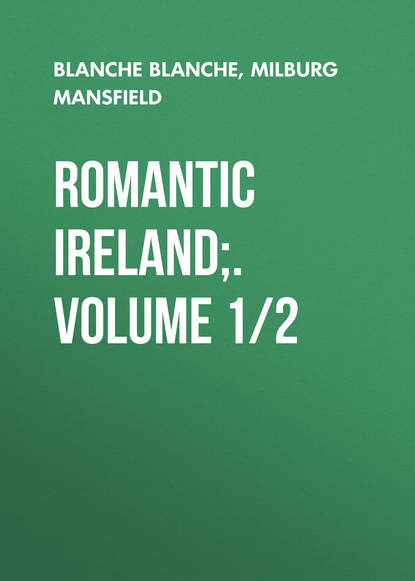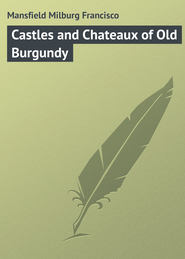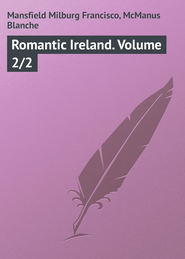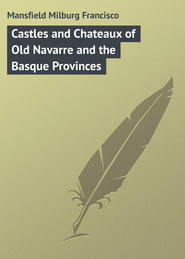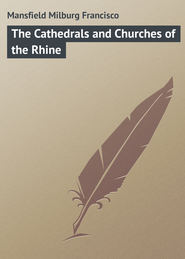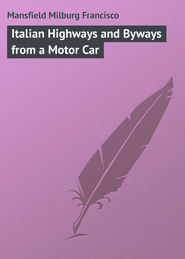По всем вопросам обращайтесь на: info@litportal.ru
(©) 2003-2024.
✖
Romantic Ireland;. Volume 1/2
Настройки чтения
Размер шрифта
Высота строк
Поля
The architectural splendour of Dublin is not very great, although certain of the chief buildings, other than the churches, are in many ways remarkable.
Dublin Castle is a group of buildings covering ten acres of ground and dating from 1205, when a castle was erected for the defence of the city. Since the time of Queen Elizabeth it has been the official residence of the viceroy. The buildings are grouped around two courts, with a chief gateway on Cork Hill. The presence-chamber, ballroom (Hall of St. Patrick), portrait-chamber, and private drawing-room are handsome and historic apartments. The lower court contains the Bermingham Tower (formerly the state prison and now used as a depository for state records), the chapel royal, and the armory.
The Bank of Ireland, formerly the Irish Parliament House, has a finely designed Ionic façade, with various adorning statues and escutcheons.
The National Gallery of Ireland ranks among the world’s great collections of pictures, and is exceedingly rich in portraiture. Some one has said that there are but three truly great – in just what way the reader may judge for himself – business streets in the world. The first is the Rue de la Paix in Paris; the second, Princes Street in Edinburgh; and the Third, Sackville Street in Dublin. All will at once notice and admire its great width, its splendid dimensions, and its singularly attractive disposition of public and commercial buildings. The chief is the general post-office, with a fine portico and pediment bearing figures of Hibernia, Mercury, and Fidelity.
The little parish of Laracor, north of Dublin, came to Swift shortly after his return to Ireland as chaplain to Lord Berkeley. “Here he had a glebe and a horse, and became domesticated,” so far as it was possible for the man to be domesticated anywhere.
Swift’s fluctuations between Ireland and London have been the subject of much comment and criticism. He had by no means settled down to the “jog-trot duties” of a small Irish vicar. Swift, the churchman, the litterateur, and the politician were much one and the same thing; and, in spite of his indiscretions, he did good service, though, to be sure, his sincerity was doubted. A story is told, of the occasion when he was urged for Bishop of Hereford, that the Archbishop of York stated to his queen “that inquiries should first be made as to whether the man is really a Christian.” He did not achieve the office, but was reconciled with the less influential deanery of St. Patrick’s at Dublin.
Swift was born in Dublin at a house in Hoey’s Court, now (?) disappeared, in 1667. He died in 1745, and is buried, not among the literary giants at Westminster, but in St. Patrick’s at Dublin, the venue of his deanship.
Swift as a satirist was unassailable in his time, and his literary reputation in general is without doubt – by reason of its versatility – greater than many a more prolific writer.
The first announcement of this master, at once comic and caustic, was the “Tale of a Tub” and “The Battle of the Books,” when followed in rapid review various political and social tracts, the inimitable “Gulliver” (1727) and the “Polite Conversation.” “Cadenus and Vanessa” appeared without the author’s consent soon after the death of its heroine, Miss Hester Vanhomrigh, in 1723; but the “Diary to Stella,” the lady whom he afterward married, did not appear until long after the author’s death.
Swift’s literary reputation – “at the head of the English prose-writers” – has been best summed up by his friend Pope in six short lines:
“…Whatever title please thine ear,
Dean, Drapier, Bickerstaff or Gulliver!
Whether you choose Cervantes’ serious air,
Or laugh and shake in Rabelais’ easy chair,
Or praise the court, or magnify mankind,
Or thy grieved country’s copper chains unbind.”
As the river Liffey, which flows through Dublin, joins the Irish Sea, it expands into a noble bay, which is guarded on the one side by the Hill of Howth, and on the other by Killiney Hill, near Kingstown.
Dublin has long been famous for the manufacture of poplin, dear to the hearts of the ladies. For many years the manufacture had declined, but a recent stimulus appears to have been given it. It was about the year 1780 that the trade first assumed a degree of importance in Dublin, though it had been introduced by the French Huguenots in the reign of William III. From that period till the Union in 1800, it had been gradually increasing in extent; but suddenly declined after the transference of the Irish Parliament to London; and Irishmen are fain to link the two events together as cause and effect.
As the author has had occasion to say before, Ireland is not the saddened, sodden, blighted land that the calamity howlers and pessimists in general would have us believe.
Certainly, in that beauteous country which lies immediately to the southward of Dublin, from Kingstown to Queenstown, there is no great evidence of sorrowing poverty; though, to be sure, there are in many parts no indications of great prosperity. There is a sort of happy mean in the lives of the Irish people; and, since the inhabitants of this particular region are domiciled in so lovely a spot, apparently they concern themselves little with regard to material wealth.
From Dublin, south, is a veritable fairy-land of splendid hills and groves, the famous garden of the county of Wicklow. Bray is admittedly the best situated watering-place in the kingdom. But, more than all else, its chief importance lies in its position as the gateway to all the beauties of County Wicklow, whose residents go farther, and call it the Garden of Ireland. One may truthfully say of Wicklow, as of the other mountainous counties of Ireland, “the more one sees of it, the more one wants to see.” Its roads for the cyclist or the automobilist are, like the Irish character, a blend of the seducing and the bold, corrugated and rough in places, but withal fascinating and appealing, if only for their variety. Powerscourt, the Dargle, the Glen of the Downs, and the Devil’s Glen are the chief points of interest upon which one first comes from Dublin. The Dargle is a wooded glen of extreme beauty, three miles from Bray, from which a little mountain stream runs at the bottom of the gorge, quite hidden at times in a depth of wooded bank which must approximate three hundred feet.
Powerscourt is beautiful enough, but it is more or less of the suburban order of attractiveness, lying as it does so near to Dublin.
The waterfall at Powerscourt is the finest in Ireland. It pours down in a long, diagonal slope over a rocky precipice three hundred feet high. When George IV. came to Powerscourt, the whole fall had been dammed up on the cliff above, with the object of letting it loose when the royal party approached, so that a fine effect might be ensured. All this trouble and expense, however, was thrown away, as the “First Gentleman in Europe” lunched so liberally at Powerscourt House that he found himself unequal to the exertion of seeing anything of the demesne.
The Dargle is rather of the conventional order of rivulet. It is not much of a stream at its fullest, but charmingly set in the woods, with mountain-tops rising over the trees, and some dainty waterfalls rather difficult to find. The four miles of road eastward to Bray are quite worth covering to see what the Dargle develops into near the coast; and, also, for the sake of the trim, rose-clad cottages, which here suggest none of that state of poverty we associate so recklessly with Ireland. One may see on the roadside notice-boards the intimation “These lands are poisoned,” and dogs, could they read, would be informed of danger to their persons. In Ireland they advertise in the papers that they are poisoning their lands “from this date,” and no dog has any remedy against the proprietors if he suffers in consequence of his illiteracy, or perhaps his meanness in not subscribing to that particular paper.
The metropolis of the Dargle valley is Enniskerry, which sounds interesting, and proves upon acquaintance to be so, though there is nothing of great moment connected with its past or present.
A few miles farther inland is Naas, the latter-day importance of which is based almost wholly upon its proximity to the race-track of the plain of Curragh and Punchestown. Naas is a delightfully quaint old town, its broad High Street being lined with little whitewashed houses, many of them tumbling down after long centuries of service. It has been narrated dolefully how Naas had once been the residence of the Kings of Leinster, but had now fallen from its high estate.
From Naas to the Punchestown race-course is down a long and winding road through typical Irish scenery. The land along the roadside is dotted with little Irish cabins, with thatched roofs and whitewashed walls, and in the low doorways are gathered old grannies and swarms of little barelegged children. On race-days it is pretty to see these little dwellings, each with its piece of bunting tied to the chimney-stack.
One may see also such sights as a chubby bareheaded boy with his arm affectionately around the neck of a fine fat pig; boy and animal equally interested in passers-by.
It does not strike one as a genuine emotion, however; but, rather, as if it were got up for the occasion and for the delectation of the throngs who attend this most famous of all Irish race-meets. It is quite on a par with the flags and festoons which decorate Naas itself on these occasions, and the legends in old Celtic and English, which the cottagers en route display. “The top of the morning to ye,” “Come back to Erin,” “A hundred thousand blessings on ye,” and “A real Irish greeting” are, after all, too forced to pass current with visitors from across channel as genuine spontaneous emotion.
On the occasion of the spring race-meeting at Punchestown, the little town of Naas is very animated. Inside the station-yard all the morning there is a mass of cabs and cars, which are taken by storm every time a train arrives from Dublin, and then with their load of passengers bump, smash, or blarney their way out. Music resounds everywhere. Even the local police have a band. This of course greatly facilitates the departure of the cars, for the horses of scores of them run away every time the band strikes up.
The three miles of narrow country lanes between Naas and Punchestown are a flying procession of cars from eight o’clock till midday, most of them moving at a cheerful stretching gallop, while children and race-card-sellers run gaily in and out, and English or transatlantic visitors hold on for dear life, wondering when and where all this recklessness will end.
The Wicklow mountains stand out in bold relief toward the east, and the clearness of the atmosphere ensures a magnificent view of a course which is situated in one of the finest bits of natural hunting country in the kingdom. The enclosures of Punchestown are very “select,” although a good deal of the riffraff is wont to assemble outside. The Irish police are extremely tolerant, and a thriving business is done in games of hazard, which have lately been ruthlessly extinguished at Epsom and Newmarket, in England. The roulette-table, the man with three cards, and his comrade with the thimble and the pea are among the recognized adjuncts of Punchestown. The country folk on the whole appear to enjoy the “sport,” and if, as is usually the case, the odds happen to be against them, they grin and bear it with naïve good humour. The bookmakers are a noisy, but, on the whole, an honest and withal humourous crowd, some offering to lay a starting price at “Newmarket, Stewmarket, or any old market, – starting price anywhere and everywhere,” while a rival will go so far as to declare: “We pay you whether you win or not.”
On a recent occasion, when King Edward visited the Punchestown races in state, it was even a more brilliant event than usual. Here a great concourse of people awaited the arrival of the king and queen, and the grand stand was closely packed with a representative assembly of Irish aristocracy. The racing provided some very excellent sport. There were very full fields; and, when the horses got away, there was a splendid splash of colour, as the jockeys in all the tints of the rainbow streamed along the emerald course.
The return from Punchestown on this occasion, as the writer has reason to remember, was far and away a wilder nightmare than any “Derby-day drive back to town” which could possibly be recalled. Imagine a solid, motionless block of cars nearly a mile long, with drivers, passengers, and police storming, threatening, and entreating, till at last a passage is slowly forced to the little wayside station at Naas. Here the railway officials had long ago given up the traffic problem in despair, and every train apparently got back to Dublin, or did not get back, by the unaided wit of the engine-driver. Yet one arrived at last, and a request to the officials for a full return of the killed and wounded was met with derision.
From the newspaper accounts the next morning we learned that:
“At a quarter to six, nearly half an hour late, the king and queen arrived in Dublin, and were met by all that was left of the population. They drove rapidly to the Viceregal Lodge, along roads crowded with cheering humanity, and looked very much pleased with their reception.”
For ourselves, after this informal procedure, we had retired to our hotel to remove somewhat the stains of pleasure-making, – which are often as ineradicable as those of battle, – and, after the inevitable “meat tea” of the smaller hostelries throughout the British Isles, followed Mr. Pepys’s practice, “and so to bed.”
Near Curragh is Monasterevan, with its ruined refuge-sanctuary, and Lea Castle. A prominent woody eminence is Spire Hill, beyond which are the picturesque ruins of Strongbow’s Castle on the isolated rock of Dunamase. Beyond is Maryborough and the plantations of Ballyfin, which clothe the feet of the Slievebloom mountains, and frame the flat bogland district. At Aghaboe, i. e., Ox-field House, stands the ancient abbey founded by St. Canice in the sixth century.
Near the river Suir is a plain-fronted, square-towered edifice, known as Loughmore Castle, and a near-by ridge with a curious notched appearance has for its name Sliav Ailduin, – the Devil’s Bit Mountain. Here is Thurles, the scene of William Smith O’Brien’s capture. Here, also, Doctor Cullen summoned a Romish council in the mid-nineteenth century.
Within three miles of Thurles is Holy Cross, where “the wearied O’Brien laid down at the feet of Death’s angel his cares and his crown.”
“There sculpture her miracles lavished around,
Until stone spoke a worship diviner than sound;
There from matins to midnight the censers were swaying,
And from matins to midnight the people were praying;
As a thousand Cistercians incessantly raised
Hosannas round shrines that with jewelry blazed.
While the palmer from Syria – the pilgrim from Spain —
Brought their offerings alike to the far-honoured fane;
And in time, when the wearied O’Brien laid down
At the feet of Death’s angel his cares and his crown,
Beside the high altar, a canopied tomb
Shed above his remains its magnificent gloom;
And in Holy Cross Abbey high masses were said,
Through the lapse of long ages, for Donald the Red.
O’er the porphyry shrine of the founder, all-riven,
No lamps glimmer now but the cressets of heaven!”
– Simmons.
Across the plain of Curragh is Kildare, i. e., Wood of Oaks, where St. Bridget founded a nunnery, in which the vestal sisterhood guarded the ever-burning fire, so beautifully and picturesquely alluded to by Moore:
“Like the bright lamp that shone in Kildare’s holy fane,
And burnt through long ages of darkness and storm,
Is the heart that deep sorrows have frowned on in vain,
Whose spirit outlives them, unfading and warm.”
Dublin Castle is a group of buildings covering ten acres of ground and dating from 1205, when a castle was erected for the defence of the city. Since the time of Queen Elizabeth it has been the official residence of the viceroy. The buildings are grouped around two courts, with a chief gateway on Cork Hill. The presence-chamber, ballroom (Hall of St. Patrick), portrait-chamber, and private drawing-room are handsome and historic apartments. The lower court contains the Bermingham Tower (formerly the state prison and now used as a depository for state records), the chapel royal, and the armory.
The Bank of Ireland, formerly the Irish Parliament House, has a finely designed Ionic façade, with various adorning statues and escutcheons.
The National Gallery of Ireland ranks among the world’s great collections of pictures, and is exceedingly rich in portraiture. Some one has said that there are but three truly great – in just what way the reader may judge for himself – business streets in the world. The first is the Rue de la Paix in Paris; the second, Princes Street in Edinburgh; and the Third, Sackville Street in Dublin. All will at once notice and admire its great width, its splendid dimensions, and its singularly attractive disposition of public and commercial buildings. The chief is the general post-office, with a fine portico and pediment bearing figures of Hibernia, Mercury, and Fidelity.
The little parish of Laracor, north of Dublin, came to Swift shortly after his return to Ireland as chaplain to Lord Berkeley. “Here he had a glebe and a horse, and became domesticated,” so far as it was possible for the man to be domesticated anywhere.
Swift’s fluctuations between Ireland and London have been the subject of much comment and criticism. He had by no means settled down to the “jog-trot duties” of a small Irish vicar. Swift, the churchman, the litterateur, and the politician were much one and the same thing; and, in spite of his indiscretions, he did good service, though, to be sure, his sincerity was doubted. A story is told, of the occasion when he was urged for Bishop of Hereford, that the Archbishop of York stated to his queen “that inquiries should first be made as to whether the man is really a Christian.” He did not achieve the office, but was reconciled with the less influential deanery of St. Patrick’s at Dublin.
Swift was born in Dublin at a house in Hoey’s Court, now (?) disappeared, in 1667. He died in 1745, and is buried, not among the literary giants at Westminster, but in St. Patrick’s at Dublin, the venue of his deanship.
Swift as a satirist was unassailable in his time, and his literary reputation in general is without doubt – by reason of its versatility – greater than many a more prolific writer.
The first announcement of this master, at once comic and caustic, was the “Tale of a Tub” and “The Battle of the Books,” when followed in rapid review various political and social tracts, the inimitable “Gulliver” (1727) and the “Polite Conversation.” “Cadenus and Vanessa” appeared without the author’s consent soon after the death of its heroine, Miss Hester Vanhomrigh, in 1723; but the “Diary to Stella,” the lady whom he afterward married, did not appear until long after the author’s death.
Swift’s literary reputation – “at the head of the English prose-writers” – has been best summed up by his friend Pope in six short lines:
“…Whatever title please thine ear,
Dean, Drapier, Bickerstaff or Gulliver!
Whether you choose Cervantes’ serious air,
Or laugh and shake in Rabelais’ easy chair,
Or praise the court, or magnify mankind,
Or thy grieved country’s copper chains unbind.”
As the river Liffey, which flows through Dublin, joins the Irish Sea, it expands into a noble bay, which is guarded on the one side by the Hill of Howth, and on the other by Killiney Hill, near Kingstown.
Dublin has long been famous for the manufacture of poplin, dear to the hearts of the ladies. For many years the manufacture had declined, but a recent stimulus appears to have been given it. It was about the year 1780 that the trade first assumed a degree of importance in Dublin, though it had been introduced by the French Huguenots in the reign of William III. From that period till the Union in 1800, it had been gradually increasing in extent; but suddenly declined after the transference of the Irish Parliament to London; and Irishmen are fain to link the two events together as cause and effect.
As the author has had occasion to say before, Ireland is not the saddened, sodden, blighted land that the calamity howlers and pessimists in general would have us believe.
Certainly, in that beauteous country which lies immediately to the southward of Dublin, from Kingstown to Queenstown, there is no great evidence of sorrowing poverty; though, to be sure, there are in many parts no indications of great prosperity. There is a sort of happy mean in the lives of the Irish people; and, since the inhabitants of this particular region are domiciled in so lovely a spot, apparently they concern themselves little with regard to material wealth.
From Dublin, south, is a veritable fairy-land of splendid hills and groves, the famous garden of the county of Wicklow. Bray is admittedly the best situated watering-place in the kingdom. But, more than all else, its chief importance lies in its position as the gateway to all the beauties of County Wicklow, whose residents go farther, and call it the Garden of Ireland. One may truthfully say of Wicklow, as of the other mountainous counties of Ireland, “the more one sees of it, the more one wants to see.” Its roads for the cyclist or the automobilist are, like the Irish character, a blend of the seducing and the bold, corrugated and rough in places, but withal fascinating and appealing, if only for their variety. Powerscourt, the Dargle, the Glen of the Downs, and the Devil’s Glen are the chief points of interest upon which one first comes from Dublin. The Dargle is a wooded glen of extreme beauty, three miles from Bray, from which a little mountain stream runs at the bottom of the gorge, quite hidden at times in a depth of wooded bank which must approximate three hundred feet.
Powerscourt is beautiful enough, but it is more or less of the suburban order of attractiveness, lying as it does so near to Dublin.
The waterfall at Powerscourt is the finest in Ireland. It pours down in a long, diagonal slope over a rocky precipice three hundred feet high. When George IV. came to Powerscourt, the whole fall had been dammed up on the cliff above, with the object of letting it loose when the royal party approached, so that a fine effect might be ensured. All this trouble and expense, however, was thrown away, as the “First Gentleman in Europe” lunched so liberally at Powerscourt House that he found himself unequal to the exertion of seeing anything of the demesne.
The Dargle is rather of the conventional order of rivulet. It is not much of a stream at its fullest, but charmingly set in the woods, with mountain-tops rising over the trees, and some dainty waterfalls rather difficult to find. The four miles of road eastward to Bray are quite worth covering to see what the Dargle develops into near the coast; and, also, for the sake of the trim, rose-clad cottages, which here suggest none of that state of poverty we associate so recklessly with Ireland. One may see on the roadside notice-boards the intimation “These lands are poisoned,” and dogs, could they read, would be informed of danger to their persons. In Ireland they advertise in the papers that they are poisoning their lands “from this date,” and no dog has any remedy against the proprietors if he suffers in consequence of his illiteracy, or perhaps his meanness in not subscribing to that particular paper.
The metropolis of the Dargle valley is Enniskerry, which sounds interesting, and proves upon acquaintance to be so, though there is nothing of great moment connected with its past or present.
A few miles farther inland is Naas, the latter-day importance of which is based almost wholly upon its proximity to the race-track of the plain of Curragh and Punchestown. Naas is a delightfully quaint old town, its broad High Street being lined with little whitewashed houses, many of them tumbling down after long centuries of service. It has been narrated dolefully how Naas had once been the residence of the Kings of Leinster, but had now fallen from its high estate.
From Naas to the Punchestown race-course is down a long and winding road through typical Irish scenery. The land along the roadside is dotted with little Irish cabins, with thatched roofs and whitewashed walls, and in the low doorways are gathered old grannies and swarms of little barelegged children. On race-days it is pretty to see these little dwellings, each with its piece of bunting tied to the chimney-stack.
One may see also such sights as a chubby bareheaded boy with his arm affectionately around the neck of a fine fat pig; boy and animal equally interested in passers-by.
It does not strike one as a genuine emotion, however; but, rather, as if it were got up for the occasion and for the delectation of the throngs who attend this most famous of all Irish race-meets. It is quite on a par with the flags and festoons which decorate Naas itself on these occasions, and the legends in old Celtic and English, which the cottagers en route display. “The top of the morning to ye,” “Come back to Erin,” “A hundred thousand blessings on ye,” and “A real Irish greeting” are, after all, too forced to pass current with visitors from across channel as genuine spontaneous emotion.
On the occasion of the spring race-meeting at Punchestown, the little town of Naas is very animated. Inside the station-yard all the morning there is a mass of cabs and cars, which are taken by storm every time a train arrives from Dublin, and then with their load of passengers bump, smash, or blarney their way out. Music resounds everywhere. Even the local police have a band. This of course greatly facilitates the departure of the cars, for the horses of scores of them run away every time the band strikes up.
The three miles of narrow country lanes between Naas and Punchestown are a flying procession of cars from eight o’clock till midday, most of them moving at a cheerful stretching gallop, while children and race-card-sellers run gaily in and out, and English or transatlantic visitors hold on for dear life, wondering when and where all this recklessness will end.
The Wicklow mountains stand out in bold relief toward the east, and the clearness of the atmosphere ensures a magnificent view of a course which is situated in one of the finest bits of natural hunting country in the kingdom. The enclosures of Punchestown are very “select,” although a good deal of the riffraff is wont to assemble outside. The Irish police are extremely tolerant, and a thriving business is done in games of hazard, which have lately been ruthlessly extinguished at Epsom and Newmarket, in England. The roulette-table, the man with three cards, and his comrade with the thimble and the pea are among the recognized adjuncts of Punchestown. The country folk on the whole appear to enjoy the “sport,” and if, as is usually the case, the odds happen to be against them, they grin and bear it with naïve good humour. The bookmakers are a noisy, but, on the whole, an honest and withal humourous crowd, some offering to lay a starting price at “Newmarket, Stewmarket, or any old market, – starting price anywhere and everywhere,” while a rival will go so far as to declare: “We pay you whether you win or not.”
On a recent occasion, when King Edward visited the Punchestown races in state, it was even a more brilliant event than usual. Here a great concourse of people awaited the arrival of the king and queen, and the grand stand was closely packed with a representative assembly of Irish aristocracy. The racing provided some very excellent sport. There were very full fields; and, when the horses got away, there was a splendid splash of colour, as the jockeys in all the tints of the rainbow streamed along the emerald course.
The return from Punchestown on this occasion, as the writer has reason to remember, was far and away a wilder nightmare than any “Derby-day drive back to town” which could possibly be recalled. Imagine a solid, motionless block of cars nearly a mile long, with drivers, passengers, and police storming, threatening, and entreating, till at last a passage is slowly forced to the little wayside station at Naas. Here the railway officials had long ago given up the traffic problem in despair, and every train apparently got back to Dublin, or did not get back, by the unaided wit of the engine-driver. Yet one arrived at last, and a request to the officials for a full return of the killed and wounded was met with derision.
From the newspaper accounts the next morning we learned that:
“At a quarter to six, nearly half an hour late, the king and queen arrived in Dublin, and were met by all that was left of the population. They drove rapidly to the Viceregal Lodge, along roads crowded with cheering humanity, and looked very much pleased with their reception.”
For ourselves, after this informal procedure, we had retired to our hotel to remove somewhat the stains of pleasure-making, – which are often as ineradicable as those of battle, – and, after the inevitable “meat tea” of the smaller hostelries throughout the British Isles, followed Mr. Pepys’s practice, “and so to bed.”
Near Curragh is Monasterevan, with its ruined refuge-sanctuary, and Lea Castle. A prominent woody eminence is Spire Hill, beyond which are the picturesque ruins of Strongbow’s Castle on the isolated rock of Dunamase. Beyond is Maryborough and the plantations of Ballyfin, which clothe the feet of the Slievebloom mountains, and frame the flat bogland district. At Aghaboe, i. e., Ox-field House, stands the ancient abbey founded by St. Canice in the sixth century.
Near the river Suir is a plain-fronted, square-towered edifice, known as Loughmore Castle, and a near-by ridge with a curious notched appearance has for its name Sliav Ailduin, – the Devil’s Bit Mountain. Here is Thurles, the scene of William Smith O’Brien’s capture. Here, also, Doctor Cullen summoned a Romish council in the mid-nineteenth century.
Within three miles of Thurles is Holy Cross, where “the wearied O’Brien laid down at the feet of Death’s angel his cares and his crown.”
“There sculpture her miracles lavished around,
Until stone spoke a worship diviner than sound;
There from matins to midnight the censers were swaying,
And from matins to midnight the people were praying;
As a thousand Cistercians incessantly raised
Hosannas round shrines that with jewelry blazed.
While the palmer from Syria – the pilgrim from Spain —
Brought their offerings alike to the far-honoured fane;
And in time, when the wearied O’Brien laid down
At the feet of Death’s angel his cares and his crown,
Beside the high altar, a canopied tomb
Shed above his remains its magnificent gloom;
And in Holy Cross Abbey high masses were said,
Through the lapse of long ages, for Donald the Red.
O’er the porphyry shrine of the founder, all-riven,
No lamps glimmer now but the cressets of heaven!”
– Simmons.
Across the plain of Curragh is Kildare, i. e., Wood of Oaks, where St. Bridget founded a nunnery, in which the vestal sisterhood guarded the ever-burning fire, so beautifully and picturesquely alluded to by Moore:
“Like the bright lamp that shone in Kildare’s holy fane,
And burnt through long ages of darkness and storm,
Is the heart that deep sorrows have frowned on in vain,
Whose spirit outlives them, unfading and warm.”





